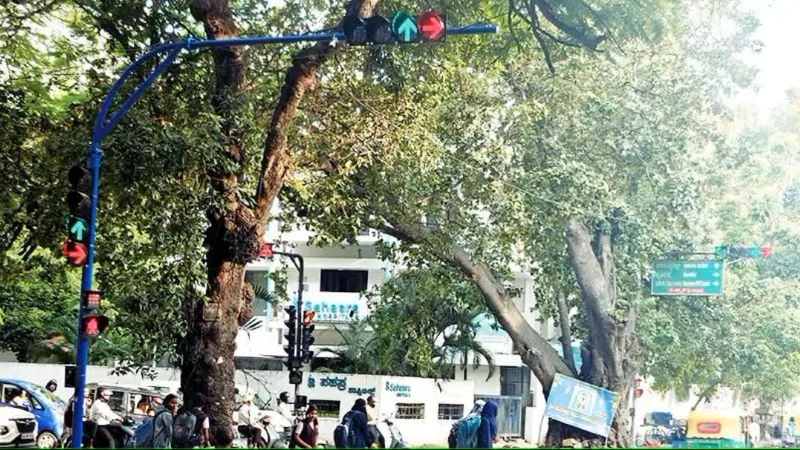Bengaluru, the capital city of Karnataka, has long been plagued by heavy traffic congestion, a problem that many fast-growing cities around the world face. With an ever-increasing population and a booming tech sector, the city has struggled to manage the rising number of vehicles on its roads. To address these challenges and improve traffic flow, the city has been exploring innovative technological solutions. One such solution is the implementation of AI-powered traffic signals, which aim to optimize traffic management based on real-time traffic data. However, as these AI systems were gradually integrated into the city’s infrastructure, a new issue arose: the unpredictability of the signal changes.
To tackle this problem, Bengaluru’s traffic police have come up with an innovative solution: the introduction of a 5-second countdown timer at traffic signals. This timer will help reduce the unpredictability of AI-powered traffic signals and provide drivers with a clear, visible indication of when the light will turn green. The countdown timer will be visible to all road users, allowing them to anticipate when they need to prepare to move. The introduction of this new feature is aimed at improving traffic flow, reducing congestion, and making the traffic management system more user-friendly.
The Problem with AI-Powered Traffic Signals
AI-powered traffic signals have been increasingly adopted by cities around the world to optimize traffic flow and reduce congestion. Unlike traditional fixed-timed signals, which follow a preset cycle of red, yellow, and green lights, AI-powered signals adjust in real time based on the amount of traffic present at an intersection. These systems use sensors and cameras to gather data about traffic density and vehicle movements, which is then analyzed by AI algorithms to adjust the signal timing accordingly.
While AI-powered traffic signals are designed to improve traffic efficiency by adjusting the timing of signals based on demand, they have faced a significant drawback: unpredictability. Since the system adjusts the signal timing in real time, it can change unexpectedly, without providing any warning to drivers. This has led to situations where drivers are caught off guard when the signal suddenly turns green, especially when they are at a red light. In some cases, this unpredictability has led to confusion, delays, and even accidents as drivers try to adjust to the sudden change in signal timing.
The unpredictability of AI-powered signals has been particularly problematic in Bengaluru, a city notorious for its chaotic traffic. As more AI-powered signals were implemented across the city, the unpredictability of these signals became an increasingly serious issue. Drivers were unsure of when to start moving, and pedestrians found it difficult to predict when they could safely cross the road. This led to frustration among commuters and a general sense of discomfort with the new system.
Introducing the Countdown Timer Solution
To address the unpredictability of AI-powered traffic signals, Bengaluru’s traffic police have decided to implement a 5-second countdown timer before the light turns green. The countdown timer will be displayed on the traffic signal, giving drivers a clear indication of when the light will change. This will allow drivers to prepare to move when the light turns green, reducing the chances of sudden starts and stops that can lead to accidents and confusion.
The countdown timer will be visible not just to drivers but also to pedestrians, allowing them to anticipate the signal change and make better decisions about when to cross the road. This added level of predictability will help improve safety for both drivers and pedestrians, ensuring smoother traffic flow and reducing the risk of accidents.
The countdown timer will also help drivers better manage their time at intersections. With the ability to predict when the light will change, drivers will be able to adjust their speed and position, avoiding the sudden acceleration that can occur when the light turns green unexpectedly. This will contribute to a smoother and more efficient flow of traffic, reducing the likelihood of congestion at busy intersections.
Expansion Plans for AI-Powered Signals
Currently, Bengaluru has over 100 junctions equipped with AI-powered traffic lights, and the city’s traffic police plan to expand this network in the coming months. By March, an additional 65 junctions will have AI-powered signals, and in the subsequent phase, the number of such junctions will rise to 300. As part of this expansion, the introduction of countdown timers will be implemented at all AI-powered traffic lights, ensuring that the system remains user-friendly and predictable as it grows.
The rollout of AI-powered traffic signals across Bengaluru is part of the city’s broader efforts to improve its traffic management system and address the growing challenges of urban mobility. By integrating smart technology with traditional traffic management infrastructure, Bengaluru is aiming to create a more efficient, sustainable, and safer transportation network.
The Benefits of Countdown Timers
The introduction of countdown timers at AI-powered traffic signals is expected to bring several benefits to Bengaluru’s traffic management system. One of the most significant advantages is the reduction of driver confusion. In the past, drivers often had to guess when the signal would turn green, leading to hesitation and delays. With the countdown timer, drivers will have a clear and predictable indication of when the light will change, allowing them to prepare and start moving smoothly.
Another key benefit is improved traffic flow. By providing a countdown before the light turns green, drivers will be able to adjust their speed and position in advance, reducing the likelihood of sudden starts and stops. This will help smooth out the flow of traffic at busy intersections, reducing congestion and improving overall efficiency. The countdown timer will also reduce the chances of unnecessary idling, as drivers will be able to anticipate when the light will change and adjust their actions accordingly.
The countdown timer will also improve pedestrian safety. Pedestrians will have a better understanding of when the light will change, allowing them to cross the street more confidently and safely. This is especially important in a city like Bengaluru, where pedestrian safety is often a concern due to the heavy traffic and the lack of dedicated pedestrian infrastructure at many intersections.
Finally, the countdown timer will make the AI-powered traffic system more user-friendly. One of the key challenges of AI-powered systems is their complexity and the difficulty in understanding how they work. By providing a simple, intuitive visual cue before the light turns green, the countdown timer will help bridge the gap between the technology and the drivers who rely on it.








